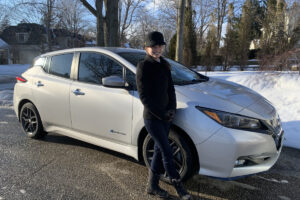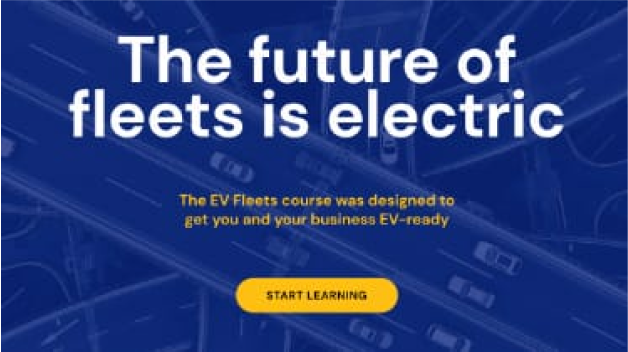Through southern Ontario’s blizzards, freezing rain, fierce winds and frigid temperatures, Electric Autonomy’s managing editor, Emma Jarratt, shares the adjustments that driving an electric vehicle in the winter requires

Electric Autonomy’s managing editor, Emma Jarratt, gives her account of EV driving in the winter. Photo: Emma Jarratt
Through southern Ontario’s blizzards, freezing rain, fierce winds and frigid temperatures, Electric Autonomy’s managing editor Emma Jarratt shares the adjustments that driving an electric vehicle in the winter requires
The winter of 2022 in southern Ontario has not been gentle.
Despite a late start with the first “real” snow only arriving in mid-January, the phrase “in like a lion” seems apt.
And while the November-through-March stretch can often feel humdrum, this season brought me a new challenge: this year I’m driving in a Toronto winter in a 2019 Nissan Leaf — my first battery electric vehicle (BEV).
After so many years of gas-powered SUVs and all-wheel drive it’s difficult to say whether the car or I had a look of greater trepidation as the first blizzard of the year started to blow. (Fifty-five centimetres, 48 hours later in minus 20 degrees and there was a palpable feeling of panic, “What have I done?”)
But for better or worse the Leaf and I are together this winter and given 79 per cent of Canadians are seeking data on EV performance in Canada’s winter, it seems documenting my learning curve could prove a useful opportunity for everyone.
Meet my Nissan Leaf
The first thing to know about this peppy 2019 SV hatchback is that she has a name: Daisy Rose. We can all thank my children for the moniker.
The second thing to know is that poor Daisy Rose had the shock of her little car life in the last six months after being uprooted from her native California homeland and shipped unceremoniously across the continent to land in my driveway mid-August 2021.
We are a one-car family and Daisy Rose’s 62.0-kWh battery pack is expected to shoulder a heavy burden what with carting around two small and busy children, their La-Z-Boy sized car seats, a pet, having all of our gear crammed in on odd and unpredictable schedules, while bravely enduring dirty shoes on her seats, smudgy fingers on her windows and shovelfuls of crumbs ground relentlessly into her every crease and cranny.
Daisy Rose tolerates all of that with the silent dignity only a BEV can muster. But three months after arrival she was staring into the abyss of the auto world: an Ontario winter.
The penetrating cold. The corrosive salt. The frozen windshield wipers. What had she done, I’m sure she wondered, in her short and climate-friendly life to deserve such a fate?
But Daisy Rose — the little Leaf that could — is rising to the challenge with gusto and is thriving while driving in the winter, despite her occasionally bumbling handler and pint-sized tormentors.
I’m delighted to eat my slice of humble pie about my momentary faltering confidence in Daisy and admit that my favourite thing about being a new EV owner is being taught so many things.
Seven lessons learned about winter driving in an EV
- Plugging in overnight is crucial cell-care. Would you ever put a baby to sleep in a freezing room with no blanket? Unlikely. Charging overnight when the mercury dips below minus 10 degrees is the auto equivalent of giving your battery baby a kiss on the head and a hot water bottle to snuggle down with through the long, cold night.
- Not being battered by the elements at a gas pump several times a week is crucial self-care. If for no other reason (though I, happily, do have many more) I would choose an EV every time, if only to get this reprieve from the wind, rain and general ick-factor of sharing a gas pump handle in a time of COVID.
- There is a “winter effect” on range in temperatures below minus 10 degrees, but it’s not dire. In the summer with no climate control and a full charge, Daisy Rose gives 407km of range — well above the certified 363km Leaf standard — for city driving. In the dead of winter with heat blasting and a full charge Daisy Rose has 307km of range, which is slightly above the common standard of 20 per cent winter battery performance loss. The winter range reduction hasn’t impeded us getting to where we need to go and, P.S., combustion vehicles lose roughly the same 20 per cent gas economy in winter, too.
- To maximize the reduced range, pre-schedule the EV warming so it occurs while still plugged into the charger before you get on the road.
- The fastest way to drain the Leaf’s battery is to drive on the highway I quickly learned — even in the warmer months. But a highway is not an appealing place to spend time in the winter anyway with weather advisories and dangerous driving warnings blaring, so it doesn’t feel like a loss to be incentivized to take the slower routes.
- EVs can get those crucial winter undercarriage car washes without damaging the battery. (Yes, this was an actual Google search of mine. The nightmare of my laptop’s unfortunate bath several years ago lives clear in my mind.)
- It is unexpectedly liberating for my conscious to not feel any guilt about idling in school parking lots, the spot for grocery pick-up or in traffic knowing that Daisy Rose’s silent purr isn’t emitting a molecule of pollution. For the first time since developing an environmental conscious I actually feel good about getting into my car, like really good.
And the verdict is?
Simply put: even though we are still at least a month and a half from spring (thank you, surly groundhog bearing ill-tidings of another six weeks of deep freeze) I have no doubt the Leaf can handle driving in a Canadian winter.
Am I surprised? Yes.
Despite being privileged enough to have access to extensive industry information about EVs, a residence where installing a residential charger was no problem, a garage and ample community support as I learned the ropes of a new way of driving, I still had a lot of question marks as I welcomed Daisy Rose into my family.
It was a leap of faith to put all my trust in an electric car to be driving my little family around with no plan B and one of my standout concerns was about how the Leaf would do in winter.
For the rest of Canadians — the vast majority of whom experience snow and ice and many of whom have none or only a few of the privileges mentioned above — it is understandable that there is a lingering reluctance to transition and a valid need for more information on what it is like to drive an EV in all climates.
For 12 years, I wore a track on the highway driving the east-west corridor from Montreal to Sarnia and as far north as Huntsville. I held fast to my stick shift and gas points cards, never feeling great about the tail of emissions behind me, but not having enough confidence in battery technology to do anything about it.
There is no teacher like real-world experience though, and for many legacy ICE drivers — including myself — actually getting in an EV and seeing it to believe it may be the only thing that soothes all concerns.
My journey into the driver’s seat of an EV began with a weekend rental of an EV. It was an economical and prudent way to test the technology and one that more Canadians could and should take advantage of in order to see if an EV is the right fit for them.
But the biggest question of all: do I ever miss my ICE vehicles and would I ever go back?
Not a chance.












